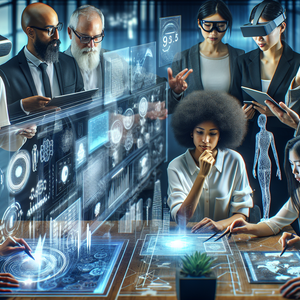The Future of Autonomous Vehicles and NVIDIA’s Vision

NVIDIA's Drive platform offers a comprehensive suite of hardware and software designed to enable the development of autonomous vehicles. This platform integrates powerful GPUs with AI capabilities, allowing cars to perceive their surroundings, make real-time decisions, and navigate complex environments. With its high-performance computing power, NVIDIA is not just a player in the automotive sector; it is a game changer. For instance, the NVIDIA Drive AGX platform serves as the brain of the vehicle, processing data from multiple sensors, including cameras, LIDAR, and radar. This data fusion enables the AV to create a detailed 3D map of its environment, essential for safe navigation. Through deep learning algorithms, these vehicles can be trained to recognize objects, predict pedestrian movements, and adapt to changing road conditions, which is crucial for minimizing accidents and enhancing passenger safety. In practical applications, companies like Tesla and Waymo have integrated NVIDIA’s technology to enhance their self-driving capabilities. Tesla’s Autopilot and Waymo’s fully autonomous taxi service leverage NVIDIA's powerful AI frameworks to interpret vast amounts of data in real-time, allowing for safer and more efficient journeys.
Innovations Driving Autonomous Vehicles Forward
NVIDIA is continually pushing the envelope with innovations that enhance the capabilities of self-driving cars. One notable advancement is the development of the NVIDIA Drive Sim, a simulation platform that allows developers to test their algorithms in virtual environments. This not only accelerates the development process but also ensures that vehicles can handle a wide range of scenarios—from urban streets to highway driving—before ever hitting the road. Moreover, NVIDIA’s collaboration with various automotive manufacturers and tech companies has led to the creation of advanced driver-assistance systems (ADAS). These systems utilize AI to provide features such as automatic lane keeping, adaptive cruise control, and emergency braking, laying the groundwork for fully autonomous driving in the future. Companies like Audi and Mercedes-Benz have integrated NVIDIA chips into their vehicles, demonstrating the widespread adoption of NVIDIA’s technology across the industry. NVIDIA's partnership with Aurora, a self-driving technology company, has resulted in innovative solutions for AVs. Their joint efforts have led to improved sensor fusion technologies and enhanced AI algorithms, which are vital for achieving higher levels of automation and safety.
Challenges on the Road to Full Autonomy
Despite the progress made, the journey toward fully autonomous vehicles is fraught with challenges. One significant hurdle is regulatory compliance. Governments worldwide are still grappling with how to legislate self-driving technology, and this uncertainty can slow down the rollout of autonomous vehicles. Additionally, public perception and trust play a crucial role; many consumers remain skeptical about the safety of self-driving cars, influenced by high-profile accidents involving autonomous technology. Another challenge is the technological complexity involved in achieving Level 5 autonomy, where a vehicle can operate without human intervention in all conditions. While NVIDIA’s technology is advanced, ensuring the AI can safely navigate every possible scenario is a monumental task. Continuous improvements in AI algorithms and sensor technology are essential to address these challenges. The fatal accident involving an Uber self-driving car in 2018 underscored the importance of safety and the need for regulatory frameworks. Such incidents not only impact public trust but also prompt lawmakers to reconsider existing regulations surrounding autonomous vehicles.
Societal Impacts of Autonomous Vehicles
The implications of widespread adoption of autonomous vehicles extend beyond just transportation. If successful, AV technology could drastically reduce traffic accidents, which are primarily caused by human error. According to the National Highway Traffic Safety Administration (NHTSA), over 90% of crashes are due to human mistakes. By removing the driver from the equation, autonomous vehicles have the potential to save thousands of lives each year. Moreover, autonomous vehicles could reshape urban landscapes. With fewer parking spaces required and the potential for shared mobility services, cities could become more pedestrian-friendly. This could lead to a reduction in traffic congestion and lower emissions, contributing to a more sustainable future. Cities like San Francisco and Los Angeles are already exploring the integration of autonomous vehicles into their public transportation systems. By doing so, they aim to reduce the number of conventional vehicles on the road and promote a cleaner, more efficient urban environment.
NVIDIA is at the forefront of the autonomous vehicle revolution, driving innovation and pushing boundaries in technology to create safer, more efficient transportation solutions. While challenges remain, the potential benefits of self-driving vehicles—ranging from enhanced safety to transformed urban environments—are too significant to ignore. As NVIDIA continues to refine its technologies and expand its partnerships, we can anticipate a future where autonomous vehicles become an integral part of our daily lives, fundamentally changing the way we move and interact with our world. With the relentless pace of innovation and collaboration in the industry, the dream of autonomous mobility is closer than ever to becoming a reality.
Autonomous Vehicle Software Engineer
Waymo, Tesla, Aurora
Core Responsibilities
Design and implement algorithms for perception, localization, and navigation in autonomous vehicles.
Collaborate with hardware teams to integrate software with sensor data from LIDAR, cameras, and radar.
Conduct simulations and testing of algorithms in both virtual and real-world environments to ensure reliability.
Required Skills
Proficiency in programming languages such as C++ and Python.
Strong understanding of machine learning and deep learning frameworks (e.g., TensorFlow, PyTorch).
Experience with robotics and autonomous systems, particularly in perception and control.
AI Research Scientist for Autonomous Systems
NVIDIA, Google AI
Core Responsibilities
Develop advanced machine learning models to improve the decision-making capabilities of autonomous vehicles.
Conduct research on novel AI techniques that can enhance safety and efficiency in self-driving technology.
Publish findings in research journals and present at conferences to contribute to the scientific community.
Required Skills
PhD or equivalent experience in Computer Science, Robotics, or a related field.
Expertise in reinforcement learning and neural networks, with a strong track record of research publications.
Familiarity with simulation tools and environments for testing AI algorithms in autonomous settings.
Autonomous Vehicle Safety Engineer
Ford, General Motors, NVIDIA, Tesla
Core Responsibilities
Evaluate and ensure the safety of autonomous vehicles through rigorous testing and validation processes.
Develop safety protocols and procedures for testing autonomous systems in various driving scenarios.
Collaborate with regulatory bodies to ensure compliance with safety standards and legislation.
Required Skills
Background in mechanical or electrical engineering, with a focus on automotive safety.
Knowledge of functional safety standards (e.g., ISO 26262) and experience with risk assessment methodologies.
Ability to analyze complex systems and identify potential safety vulnerabilities.
Data Scientist for Autonomous Vehicle Analytics
Uber ATG, Lyft
Core Responsibilities
Analyze large datasets generated by autonomous vehicles to extract insights on performance and improvement areas.
Develop predictive models to enhance vehicle behavior based on driver and environmental data.
Collaborate with engineering teams to implement data-driven solutions for real-time analytics.
Required Skills
Proficiency in data analysis tools and programming languages such as R or Python.
Strong statistical background and experience with big data technologies (e.g., Hadoop, Spark).
Excellent problem-solving skills and the ability to communicate complex data insights to non-technical stakeholders.
Systems Integration Engineer for Autonomous Vehicles
Toyota, Honda, NVIDIA, Bosch
Core Responsibilities
Oversee the integration of hardware and software systems in autonomous vehicles to ensure seamless functionality.
Troubleshoot and resolve integration issues that arise during development and testing phases.
Collaborate with cross-functional teams to align system requirements and specifications.
Required Skills
Strong background in systems engineering, with experience in automotive or robotics industries.
Proficiency in system modeling and simulation tools, as well as familiarity with embedded systems.
Excellent communication skills to work effectively with diverse teams.


